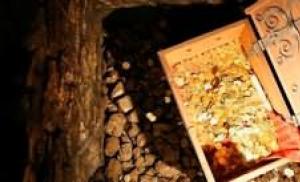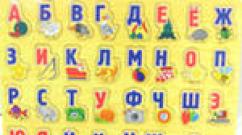Ionic reaction equations. Rules for composing equations of ion-molecular reactions
SO 4 2- + Ba 2+ → BaSO 4 ↓
Algorithm:
We select a counterion for each ion using the solubility table to obtain a neutral molecule - a strong electrolyte.
1. Na 2 SO 4 + BaCl 2 → 2 NaCl + BaSO 4
2. BaI 2 + K 2 SO 4 → 2KI + BaSO 4
3. Ba(NO 33) 2 + (NH 4) 2 SO 4 → 2 NH 4 NO 3 + BaSO 4
Ionic complete equations:
1. 2 Na + + SO 4 2- + Ba 2- + 2 Cl‾ → 2 Na + + 2 Cl‾ + BaSO 4
2. Ba 2+ + 2 I‾ + 2 K + + SO 4 2- → 2 K + + 2 I‾ + BaSO 4
3. Ba 2+ + 2 NO 3 ‾ + 2 NH 4 + + SO 4 2- → 2 NH 4 + + 2 NO 3 ‾ + BaSO 4
Conclusion: to one short equation You can create many molecular equations.
TOPIC 9. HYDROLYSIS OF SALT
Hydrolysis of salts – ion exchange reaction of salt with water, leading to
from Greek “hydro” to the formation of a weak electrolyte (or
Water, “lysis” - of a weak base or weak acid) and change-
decomposition depending on the solution environment.
Any salt can be represented as a product of the interaction of a base with
acid.
Strong Weak Strong Weak can be formed
1. LiOH NH 4 OH or 1. H 2 SO 4 everything else - 1. Strong base and
2. NaOH NH 3 · H 2 O 2. HNO 3 with a weak acid.
3. KOH everything else - 3. HCl 2. Weak base and
4. RbOH 4. HBr strong acid.
5. CsOH 5. HI 3. Weak base and
6. FrOH 6. HClO 4 weak acid.
7. Ca(OH) 2 4. Strong base and
8. Sr(OH) 2 strong acid.
9. Ba(OH) 2
COMPILATION OF IONIC-MOLECULAR HYDROLYSIS EQUATIONS.
SOLUTION OF TYPICAL PROBLEMS ON THE TOPIC: “HYDROLYSIS OF SALT”
Task No. 1.
Draw up ion-molecular equations for the hydrolysis of Na 2 CO 3 salt.
Algorithm Example
1. Create a disso equation
cation of salt into ions. Na 2 CO 3 → 2Na + + CO 3 2- Na + → NaOH - strong
2. Analyze how CO 3 2- →H 2 CO 3 is weak
Base and what acidic
that is where salt is formed. product
3. Conclude what kind of hydrolysis
white electrolyte – product
hydrolysis.
4. Write the hydrolytic equations
I stage.
A) compose a short ionic I. a) CO 3 2- + H + │OH ‾ HCO 3 ‾ + OH‾
equation, determine the environment
solution. pH>7, alkaline environment
B) form a complete ionic b) 2Na + +CO 3 2- +HOH Na + +HCO 3 ‾ +Na + +OH ‾
equation, knowing that the molecule
la – electrically neutral cha-
stitsa, pick up for everyone
counterion ion.
B) make up a molecular c) Na 2 CO 3 + HOH NaHCO 3 + NaOH
hydrolysis equation.
Hydrolysis proceeds stepwise if the weak base is polyacid and the weak acid is polybasic.
Stage II (see algorithm above NaHCO 3 Na + + HCO 3 ‾
1, 2, 3, 4a, 4b, 4c). II. a) HCO 3 ‾ + HOH H 2 CO 3 + OH ‾
B) Na + + HCO 3 ‾ H 2 CO 3 + Na + + OH ‾
B) NaHCO 3 + HOH H 2 CO 3 + NaOH
Conclusion: salts formed by strong bases and weak acids undergo partial hydrolysis (at the anion), the solution medium is alkaline (pH>7).
Task No. 2.
Draw up ion-molecular equations for the hydrolysis of ZnCl 2 salt.
ZnCl 2 → Zn 2+ + 2 Cl ‾ Zn 2+ → Zn(OH) 2 – weak base
Cl ‾ → HCl – strong acid
I. a) Zn 2+ + H + /OH ‾ ZnOH + + H+ acidic environment, pH<7
B) Zn 2+ + 2 Cl ‾ + HOH ZnOH + + Cl ‾ + H + + Cl ‾
B) ZnCl 2 + HOH ZnOHCl + HCl
II. a) ZnOH + + HOH Zn(OH) 2 + H +
B) ZnOH + + Cl ‾ + HOH Zn(OH) 2 + H + + Cl ‾
B) ZnOHCl + HOH Zn(OH) 2 + HCl
Conclusion: salts formed by weak bases and strong acids undergo partial hydrolysis (by cation), the solution medium is acidic.
Task No. 3.
Draw up ion-molecular equations for the hydrolysis of Al 2 S 3 salt.
Al 2 S 3 → 2 Al 3+ + 3 S 2- Al 3+ → Al(OH) 3 – weak base
S 2- → H 2 S – weak acid
a), b) 2 Al 3+ + 3 S 2- + 6 HOH → 2 Al(OH) 3 ↓ + 3 H 2 S
c) Al 2 S 3 + 6 H 2 O → 2 Al(OH) 3 + 3 H 2S S
Conclusion: salts formed by weak bases and weak acids undergo complete (irreversible) hydrolysis, the solution medium is close to neutral.
Instructions
On the left side of the equation, write the substances involved in the chemical reaction. They are called "raw materials". On the right side, respectively, are the formed substances (“reaction products”).
The number of atoms of all elements on the left and right sides of the reaction must be . If necessary, “balance” the quantity by selecting coefficients.
When writing an equation for a chemical reaction, first make sure that it is possible at all. That is, that its occurrence does not contradict the known physical and chemical rules and properties of substances. For example, the reaction:
NaI + AgNO3 = NaNO3 + AgI
It proceeds quickly and completely; during the reaction, an insoluble light yellow precipitate of silver iodide is formed. And the reverse reaction:
AgI + NaNO3 = AgNO3 + NaI - is impossible, although it is written in the correct symbols, and the number of atoms of all elements on the left and right sides is the same.
Write the equation in "full" form, that is, using their molecular formulas. For example, the reaction for the formation of sulfate precipitate:
BaCl2 + Na2SO4 = 2NaCl + BaSO4
Or you can write the same reaction in ionic form:
Ba 2+ + 2Cl- + 2Na+ + SO4 2- = 2Na+ + 2Cl- + BaSO4
In the same way, you can write the equation of another reaction in ionic form. Remember that each molecule of a soluble (dissociating) substance is written in ionic form, identical ions on the left and right sides of the equation are excluded.
A tangent to a curve is a straight line that is adjacent to this curve at a given point, that is, it passes through it so that in a small area around this point it is possible to replace the curve with a segment of the tangent without much loss of accuracy. If this curve is a graph of a function, then the tangent to it can be constructed using a special equation.
Instructions
Let's say you have a graph of some function. Through two points lying on this, a straight line can be drawn. Such a line intersecting the graph of a given function at two points is called a secant.
If, leaving the first point in place, you gradually move the second point in its direction, then the secant will gradually begin to rotate, tending to some specific position. Eventually, when the two points merge into one, the secant will fit snugly against yours at that single point. Otherwise, the secant will turn into a tangent.
Any inclined (that is, not vertical) line on the coordinate plane is a graph of the equation y = kx + b. The secant passing through the points (x1, y1) and (x2, y2) must therefore satisfy the conditions:
kx1 + b = y1, kx2 + b = y2.
Solving this system of two linear equations, we obtain: kx2 - kx1 = y2 - y1. Thus k = (y2 - y1)/(x2 - x1).
When the distance between x1 and x2 approaches zero, the differences turn into differentials. Thus, in the equation of the tangent passing through the point (x0, y0), the coefficient k will be equal to ∂y0/∂x0 = f′(x0), that is, the value of the derivative of the function f(x) at the point x0.
To find out the coefficient b, we substitute the already calculated value of k into the equation f′(x0)*x0 + b = f(x0). Solving this equation for b, we get that b = f(x0) - f′(x0)*x0.
As an example, consider the equation of the tangent to the function f(x) = x^2 at the point x0 = 3. The derivative of x^2 is equal to 2x. Therefore, the tangent equation takes the form:
y = 6*(x - 3) + 9 = 6x - 9.
The correctness of this equation is easy
Topic: Chemical bond. Electrolytic dissociation
Lesson: Writing Equations for Ion Exchange Reactions
Let's create an equation for the reaction between iron (III) hydroxide and nitric acid.
Fe(OH) 3 + 3HNO 3 = Fe(NO 3) 3 + 3H 2 O
(Iron (III) hydroxide is an insoluble base, therefore it is not subjected to. Water is a poorly dissociated substance; it is practically not dissociated into ions in solution.)
Fe(OH) 3 + 3H + + 3NO 3 - = Fe 3+ + 3NO 3 - + 3H 2 O
Cross out the same number of nitrate anions on the left and right and write the abbreviated ionic equation:
Fe(OH) 3 + 3H + = Fe 3+ + 3H 2 O
This reaction proceeds to completion, because a slightly dissociable substance is formed - water.
Let's write an equation for the reaction between sodium carbonate and magnesium nitrate.
Na 2 CO 3 + Mg(NO 3) 2 = 2NaNO 3 + MgCO 3 ↓
Let's write this equation in ionic form:
(Magnesium carbonate is insoluble in water and therefore does not break down into ions.)
2Na + + CO 3 2- + Mg 2+ + 2NO 3 - = 2Na + + 2NO 3 - + MgCO 3 ↓
Let's cross out the same number of nitrate anions and sodium cations on the left and right, and write the abbreviated ionic equation:
CO 3 2- + Mg 2+ = MgCO 3 ↓
This reaction proceeds to completion, because a precipitate is formed - magnesium carbonate.
Let's write an equation for the reaction between sodium carbonate and nitric acid.
Na 2 CO 3 + 2HNO 3 = 2NaNO 3 + CO 2 + H 2 O
(Carbon dioxide and water are products of the decomposition of the resulting weak carbonic acid.)
2Na + + CO 3 2- + 2H + + 2NO 3 - = 2Na + + 2NO 3 - + CO 2 + H 2 O
CO 3 2- + 2H + = CO 2 + H 2 O
This reaction proceeds to completion, because As a result, gas is released and water is formed.
Let's create two molecular reaction equations, which correspond to the following abbreviated ionic equation: Ca 2+ + CO 3 2- = CaCO 3 .
The abbreviated ionic equation shows the essence of the ion exchange reaction. In this case, we can say that to obtain calcium carbonate, it is necessary that the composition of the first substance include calcium cations, and the composition of the second - carbonate anions. Let's create molecular equations for reactions that satisfy this condition:
CaCl 2 + K 2 CO 3 = CaCO 3 ↓ + 2KCl
Ca(NO 3) 2 + Na 2 CO 3 = CaCO 3 ↓ + 2NaNO 3
1. Orzhekovsky P.A. Chemistry: 9th grade: textbook. for general education establishment / P.A. Orzhekovsky, L.M. Meshcheryakova, L.S. Pontak. - M.: AST: Astrel, 2007. (§17)
2. Orzhekovsky P.A. Chemistry: 9th grade: general education. establishment / P.A. Orzhekovsky, L.M. Meshcheryakova, M.M. Shalashova. - M.: Astrel, 2013. (§9)
3. Rudzitis G.E. Chemistry: inorganic. chemistry. Organ. chemistry: textbook. for 9th grade. / G.E. Rudzitis, F.G. Feldman. - M.: Education, OJSC “Moscow Textbooks”, 2009.
4. Khomchenko I.D. Collection of problems and exercises in chemistry for high school. - M.: RIA “New Wave”: Publisher Umerenkov, 2008.
5. Encyclopedia for children. Volume 17. Chemistry / Chapter. ed. V.A. Volodin, Ved. scientific ed. I. Leenson. - M.: Avanta+, 2003.
Additional web resources
1. A unified collection of digital educational resources (video experiences on the topic): ().
2. Electronic version of the journal “Chemistry and Life”: ().
Homework
1. In the table, mark with a plus sign the pairs of substances between which ion exchange reactions are possible and proceed to completion. Write reaction equations in molecular, full and reduced ionic form.
|
Reacting substances |
K2 CO3 |
AgNO3 |
FeCl3 |
HNO3 |
|
|
CuCl2 |
|||||
2. p. 67 No. 10,13 from the textbook P.A. Orzhekovsky “Chemistry: 9th grade” / P.A. Orzhekovsky, L.M. Meshcheryakova, M.M. Shalashova. - M.: Astrel, 2013.
When any strong acid is neutralized by any strong base, for each mole of water formed, about the heat is released:
This suggests that such reactions are reduced to one process. We will obtain the equation for this process if we consider in more detail one of the given reactions, for example, the first. Let's rewrite its equation, writing strong electrolytes in ionic form, since they exist in solution in the form of ions, and weak electrolytes in molecular form, since they are in solution mainly in the form of molecules (water is a very weak electrolyte, see § 90):
Considering the resulting equation, we see that the ions did not undergo changes during the reaction. Therefore, we will rewrite the equation again, eliminating these ions from both sides of the equation. We get:
Thus, the reactions of neutralization of any strong acid with any strong base come down to the same process - the formation of water molecules from hydrogen ions and hydroxide ions. It is clear that the thermal effects of these reactions must also be the same.
Strictly speaking, the reaction of the formation of water from ions is reversible, which can be expressed by the equation
However, as we will see below, water is a very weak electrolyte and dissociates only to a negligible extent. In other words, the equilibrium between water molecules and ions is strongly shifted towards the formation of molecules. Therefore, in practice, the reaction of neutralization of a strong acid with a strong base proceeds to completion.
When mixing a solution of any silver salt with hydrochloric acid or with a solution of any of its salts, a characteristic white cheesy precipitate of silver chloride is always formed:
![]()
Such reactions also come down to one process. In order to obtain its ionic-molecular equation, we rewrite, for example, the equation of the first reaction, writing strong electrolytes, as in the previous example, in ionic form, and the substance in the sediment in molecular form:
As can be seen, the ions do not undergo changes during the reaction. Therefore, we exclude them and rewrite the equation again:
This is the ion-molecular equation of the process under consideration.
Here we must also keep in mind that the silver chloride precipitate is in equilibrium with the ions in solution, so that the process expressed by the last equation is reversible:
However, due to the low solubility of silver chloride, this equilibrium is very strongly shifted to the right. Therefore, we can assume that the reaction of formation from ions is almost completed.
The formation of a precipitate will always be observed when there are significant concentrations of and ions in one solution. Therefore, with the help of silver ions it is possible to detect the presence of ions in a solution and, conversely, with the help of chloride ions - the presence of silver ions; An ion can serve as a reactant on an ion, and an ion can serve as a reactant on an ion.
In the future, we will widely use the ionic-molecular form of writing equations for reactions involving electrolytes.
To draw up ion-molecular equations, you need to know which salts are soluble in water and which are practically insoluble. The general characteristics of the solubility of the most important salts in water are given in Table. 15.
Table 15. Solubility of the most important salts in water

Ionic-molecular equations help to understand the characteristics of reactions between electrolytes. Let us consider, as an example, several reactions that occur with the participation of weak acids and bases.
As already mentioned, the neutralization of any strong acid by any strong base is accompanied by the same thermal effect, since it comes down to the same process - the formation of water molecules from hydrogen ions and hydroxide ions.
However, when neutralizing a strong acid with a weak base, or a weak acid with a strong or weak base, the thermal effects are different. Let's write ion-molecular equations for such reactions.
Neutralization of a weak acid (acetic acid) with a strong base (sodium hydroxide):
Here, the strong electrolytes are sodium hydroxide and the resulting salt, and the weak electrolytes are acid and water:
As can be seen, only sodium ions do not undergo changes during the reaction. Therefore, the ion-molecular equation has the form:
Neutralization of a strong acid (nitrogen) with a weak base (ammonium hydroxide):
Here we must write the acid and the resulting salt in the form of ions, and ammonium hydroxide and water in the form of molecules:
The ions do not undergo changes. Omitting them, we obtain the ionic-molecular equation:
Neutralization of a weak acid (acetic acid) with a weak base (ammonium hydroxide):
In this reaction, all substances except those formed are weak electrolytes. Therefore, the ion-molecular form of the equation looks like:
Comparing the obtained ion-molecular equations with each other, we see that they are all different. Therefore, it is clear that the heats of the reactions considered are also different.
As already indicated, the reactions of neutralization of strong acids with strong bases, during which hydrogen ions and hydroxide ions combine to form a water molecule, proceed almost to completion. Neutralization reactions, in which at least one of the starting substances is a weak electrolyte and in which molecules of weakly associated substances are present not only on the right, but also on the left side of the ion-molecular equation, do not proceed to completion.
They reach a state of equilibrium in which the salt coexists with the acid and base from which it was formed. Therefore, it is more correct to write the equations of such reactions as reversible reactions.













